TEST: ALAN CATHCART | PHOTOGRAPHY: STEPHEN PIPER
With its revolutionary hub-centre steering system, the Motoinno TS3 puts Aussie innovation front and centre…
Ever since the invention of the telescopic fork in 1908 by Britain’s Alfred Angas Scott, founder of the Scott Motor Cycle Company, engineers have been looking for alternative means of mounting the front wheel in a motorcycle. In the 1930s, BMW took Scott’s undamped concept to the next level on its R12 and R17 models, the first production motorcycles carrying a hydraulically damped telescopic fork. Denmark’s Nimbus concern followed suit in 1939, introducing hydraulic damping on its fourcylinder models. And in the 40s, after the hiatus caused by WW2, telescopic fork front suspension rapidly became the norm globally.
While the tele fork is still today the go-to option for motorcycle manufacturers, it is also known to suffer from many drawbacks.
Hence, other approaches have been tried and tested over the years. These include hub-centred, Telelever and Duolever systems, girder forks, and more radical alternatives such as the RADD front end on Yamaha’s GTS1000 (see
breakout). But none has brought about a real paradigm shift – still the search continues.
The most recent attempt has emanated from Australia, where Queenslanders Ray Van Steenwyk and Colin Oddy have founded
Motorcycle Innovation Pty Ltd in Brisbane to develop their hub centre prototype – the Motoinno TS3 (for Triangulated Steering and Suspension System). This proof-of- concept prototype uses a stock 2002 Ducati 900SS engine in a radical chassis as the platform to develop their unique front-end suspension and separate steering system, for what they hope will be eventual worldwide sale. And since I may immodestly claim to have extensive experience of both riding and racing motorcycles with alternative front-end designs, they invited me to come and sample the result.
But first off, what led to this? Van Steenwyk, 53, has more than 30 years’ experience in advertising, feature film and TV production work, meaning he has a solid background in art direction, 3D animation, and media design and production.
He’s also a self-taught mechanical engineer who’s proficient in CAD, and has studied motorcycle dynamics. Business partner Colin Oddy, 64, is likewise a veteran of the TV and movie sector, and has the ability to source both finance and hardware to make abstract concepts a reality. A good team.
“In 1995, after finishing up a really tough movie shoot, I got laid low with chronic fatigue for eight months,” recounts Ray. “During that time I had nothing to do except think, and since one of my passions was restoring old motorcycles, I’d started to notice all the different fork designs and steering geometry. But I also became aware of the copious drawbacks of tele forks, so I figured there must be a better way to do this.
“After hoovering up everything I could find written about alternative front suspension, I started work on designing something different than teles. But this had to be squeezed in between my film industry work, so it actually took me 10 years to figure out this current design. Having done so, my business partner Colin urged me to quit playing with the CAD mouse and actually build the bike. I was up in Canada working on the Incredible Hulk when he convinced me, so I quit the same week and came back to Australia to set up Motorcycle Innovation with him. The TS3 is the result.”
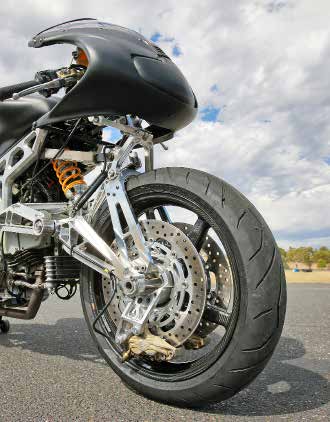

ABOVE: The rear shock is operated by the machined billet-aluminium swing arm pivoting in the Ducati engine’s crankcases, via a direct-action cantilever
The machine was developed over a seven year period, and in 2009 the design was fed to a fabricator who unfortunately made them lose momentum by doing nothing for 12 months. “We lost $20,000 in parts and materials to this man of daily excuses,” says Colin. “We finally had to pull the plug on him after only two finished and usable components were made within the space of a year.
We were haemorrhaging money, so we borrowed a ute and arrived at the workshop unannounced, loaded the engine and left without retrieving any of our raw materials, which had somehow got used for other people’s jobs.”
Still, this meant that Van Steenwyk was forced to adapt his film industry talents to become an expert in CNC machining and chrome-moly welding.
“It wasn’t a total loss in the end,” says Ray. “My bullshit meter is now very well refined, and I got an apprenticeship in fabrication, even though it was an expensive and frustrating one.”
“I’d started to notice all the different fork designs… I figured there must be a better way to do this”
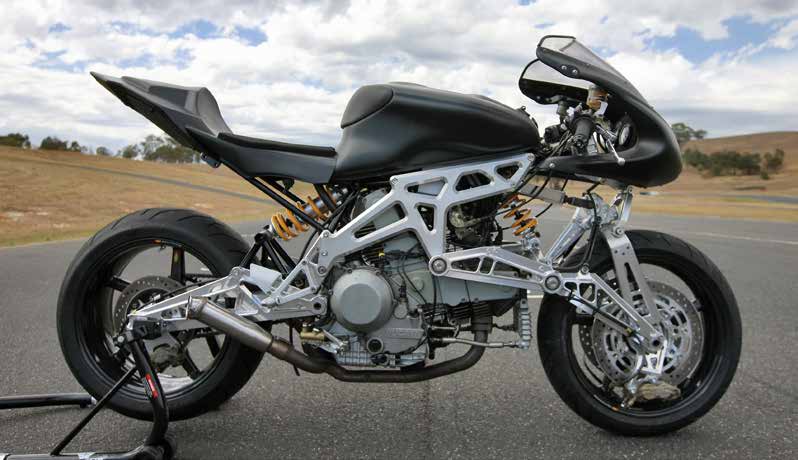
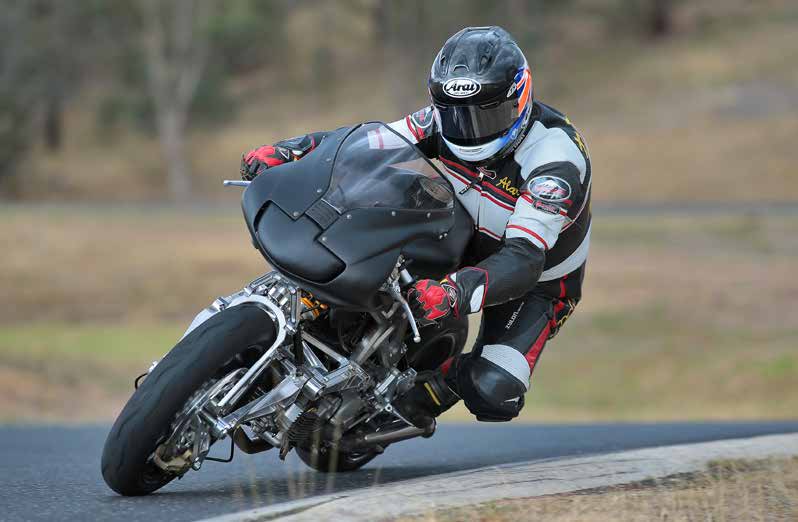
The TS3 has already attracted interest from two racing teams and a manufacturer. Ray and
Colin are are also on the lookout for an equity investor (or two) who understands the industry.
Fork me – a strange old story
DESPITE ITS ALMOST universal use, the telescopic fork is known to suffer from various issues. One of these is stiction caused by increased friction driven by the fork tubes bending slightly, aka deflection. This happens most commonly under heavy braking, when brake dive will use up wheel travel and thus diminish damping capability, as well as delivering inconsistent steering geometry during turn-in. Braking forces fed through the suspension cause it to compress under load, and thus to reduce rake and trail, making the handling more nervous, while conversely assisting with turn-in to the apex of a given bend. Furthermore, the fact that steering and suspension are coupled together means that one influences the other to the detriment of each.
To a large extent, technology has been developed to paper over these deficiencies, and more than a century on from when Scott invented it, the tele fork still rules.
BMW today remains the only volume production manufacturer to fit a “funny” front end to its customer models. But it should
be noted that the Telever front end adorning the mainstream Boxer models is a duplication of the Saxtrak front suspension design created by British engineer Nigel Hill, which he unfortunately omitted to patent.
And the Duolever fork BMW fits to its K-series models is a copy of the fourche Fior invented by maverick French designer Claude Fior back in 1978 – only it wasn’t him who patented it. F1 mechanic Norman Hossack had the same idea a couple of years later, and this time he did patent it. But he forgot to keep up the renewal payments, leaving BMW free to jump in and appropriate it free of charge.
There have been dozens of other attempts to build a better front end over the past century, starting with the hub-centre Ner-A-Car produced on both sides of the Atlantic after its 1921 debut, on which Cannonball Baker rode from New York to Los Angeles in 1922, covering more than 3300 miles in just over seven days on a device powered by a tiny 221cc engine. Comparable hub-centre systems were developed by Britain’s Jack Difazio in the 1970s, as used most famously on the Mead & Tomkinson Kawasaki endurance racer nicknamed Nessie, then by French designers Alain de Cortanze and Daniel Trema on the myriad different versions of the ELF 500GP and FIM Endurance racers, through to the modern day Bimota Tesi (below) and its Vyrus cousin. Radically different non-tele fork designs have also come from Ernie Earles, Jean-Bertrand Bruneau, Phil Irving, Andy Stevenson, John Britten, and of course US engineer James Parker, whose RADD front end equipped the avant-garde
Yamaha GTS1000.
Sadly for those who believe that motorcycle chassis designers shouldn’t stay rooted in the past, but instead invest in the future, the Yamaha wasn’t a commercial success, and no other volume manufacturer – apart from BMW – has dared since then to swim against the tide of convention.

In 2011 the TS3 was finally assembled, and in November of that year, track testing got under way. Eminent expertise was on hand in the shape of the late Warren Willing – in between trying to make the factory Ducati Desmosedici handle properly for Valentino Rossi, Willing worked with the duo to produce a compliant and stable-handling bike.
The final version was subjected to a same-day comparison test with a Suzuki GSX-R750, and delivered impressive results. The Motoinno TS3 had a consistently higher turn rate than the Suzuki, for less lean. It was able to enter a corner faster under brakes, hold a tighter line, and could be picked up faster on the exit.
At this stage the pair secured a Commercialisation Australia Skills and Knowledge grant of $50,000.
“This essentially funded our patent protection process on the front end design,” says Ray. “The next step will be a $250,000 manufacturing grant, to enable us to start producing bikes for sale.
The grants are relatively rare – with the decline in Aussie manufacturing, only two or three other manufacturing people have applied, compared to IT and suchlike. We have to bring an investor to the party to obtain that, so that the government will effectively match their investment – but we’re hopeful of finding someone who’s interested.”
The pair are keen to build a sportsbike powered by the 2014 Ducati Testastretta 11º Monster 1200 powerplant. Even though this engine is down on horsepower compared to other Ducati engines, with around 112kW compared to the top-end 149kW Panigale 1299, the TS3’s great power to weight ratio will easily make up for this, and the engine has great midrange torque, exactly what’s needed for a well-balanced motorcycle that is safe and fun to ride. And, as Van Steenwyk points out, “the Testastretta engine retains all the necessary hard points to be able to put the design of the TS3 straight into production.”
Okay, so that’s the future, but now the present: how does the prototype perform? What struck me at once the first time I rode the TS3 in Queensland was how slim and nimble it is. I had a 900SS Ducati in my garage for six years, so I know how that handles, and the TS3 is way more agile in changing direction.
It’s flickable and highly manoeuvrable without feeling nervous, with a wide 54º steering lock compared to around 38º on a tele-forked bike that results in an ultra-tight turning circle, that’s little more than twice the length of the bike – this would
be great to use in city streets. And compared to the Bimota Tesi I raced for the Italian factory for three years (whose steering lock was adversely affected by the horizontal swingarms either side of the front wheel), there’s no fear of running out of ground clearance on the TS3.
“Next step will be a $250,000 manufacturing grant, to enable us to produce bikes for sale”
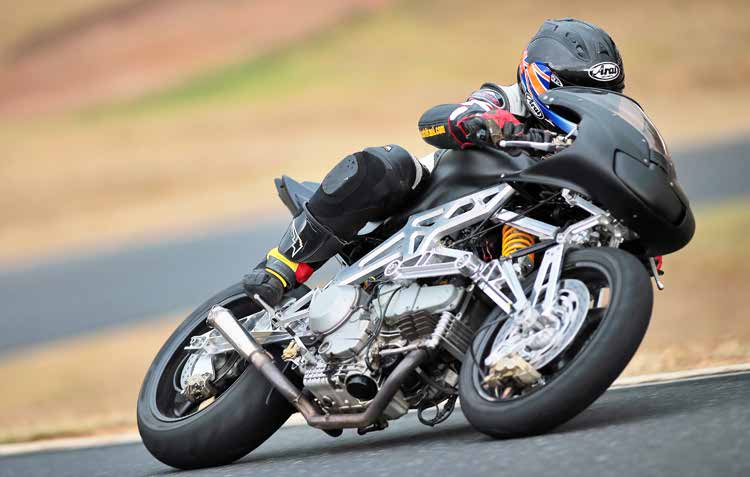
The TS3 has parallelogram swingarms which together with the triangulated steering mechanism keep rake and trail geometry constant throughout suspension travel
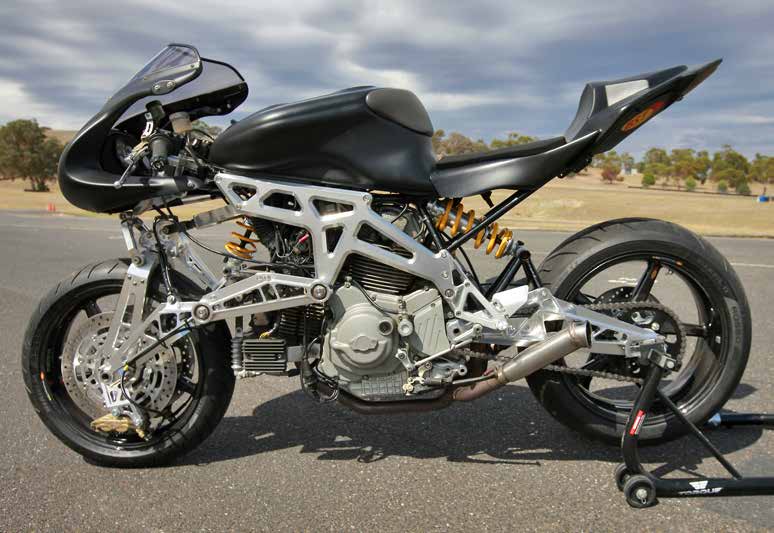
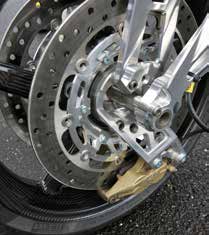
South African-made BST carbon wheels reduce rotational mass by a claimed 50 per cent on the front wheel, and 30 per cent at the rear. This helps the bike to accelerate and brake better, and lightens up the steering. The bike’s radical steering geometry has an effective head angle that can be adjusted between 15º and 24º.
According to Ray, empirical track testing has indicated that when set to its maximum of 24º the steering becomes lighter and quicker; at its minimum of 15º it becomes heavier and slower – quite the opposite of a tele-fork set-up.
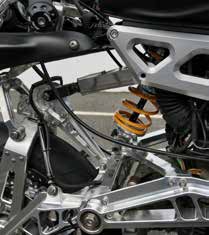
“The biggest problem with any fork,” Ray explains, “is oscillation harmonics – a vibration frequency that unsettles the front of the bike. Ours is the only system with a virtual kingpin that starts at the contact patch of the tyre, travels through the hub centre along the steering axis, and ends above the front wheel. The whole system is perfectly triangulated from the wheel axle back to the suspension arms, and then to a point above the front wheel, making it extremely strong and reducing the chance of oscillation harmonics arising from the wheel or the kingpin to almost zero.

The TS3’s front swingarm pivots directly off the Ducati engine’s front mounting lug, making the engine a fully stressed chassis
member. Because steering is separated from the suspension and braking force, there’s no need for a bulky, strong and heavy chassis. This reduces the overall weight considerably. In spite of being over-engineered and therefore heavier in prototype form than it would be in production, the TS3 has a dry weight of just 161kg, with a 52/48 per cent split on a tight 1394mm wheelbase. This is 30kg lighter than the stock 198kg Ducati 900SS.
I doubt I ever went through the Broadford Esses quicker than I did on the TS3
However, during this initial test of the bike in Queensland, a major design fault became apparent. As I speeded up I began encountering a severe front end shimmy if I hit a bump when even slightly leaned over from vertical. This lack of stability was dramatic enough to be frightening.
The problem was quickly diagnosed just by holding the front wheel between my legs and wiggling the handlebar, which revealed a huge amount of slop. It turned out the rose joint in the steering had worn quite dramatically, necessitating a redesign as well as an upgrade of the component.
While addressing these issues, Van Steenwyk also adapted the bike to use BST carbon wheels. Ten months later it was time for me to try the TS3 again, this time at Broadford in Victoria.
I’ll admit to some trepidation as I upped the pace at the tight, twisty track, which we were able to use thanks to the support of track manager Nick Selleck. But I needn’t have worried – Van Steenwyk had done his homework. The near-terminal shimmy had been replaced by a great sense of stability and composure, inspiring confidence.
Moreover, the supple suspension was sufficiently well damped to absorb Broadford’s more significant bumps on the angle.
As I upped the pace and gradually began using all of the front Pirelli’s contact patch to increase and hold turn speed, the TS3 responded well. I could brake later and later on the angle into a turn like the 180º right-hander by the Paddock entrance, or best of all the uphill turn one at the end of the pit straight, where holding off the brakes to a point that would have been suicidal on a tele-forked bike allowed me to keep up hard-earned uphill momentum as I rounded the turn onto the top straight. There, the TS3 rode the bumps really well, even with enough torque from the desmodue motor to lift the front wheel over the first step. Even though there was no steering damper, it would only flap the front wheel once very quickly, before resuming normal service. And best of all it was very stable under hard braking from high speed, even trailbraking into the off-camber right at the end of the straight, with not a trace of the shimmy it had suffered from previoulsy.
I doubt I have ever been through the Esses quicker on any of the 50 or so bikes I’ve ridden at Broadford over the years than I did on the TS3 – although it was repeatedly briefly pushed off line riding over a bump on the apex of the right-hand exit while still off the throttle, most likely due to too soft a setting on the front shock to cope with the weight transfer going downhill.
But I got enough seat time on the TS3 to be convinced that Oddy and Van Steenwyk are onto something here. Apart from looking good in a completely radical kind of way, the Motoinno concept has a lot going for it. The constant frontend geometry it offers at all times, even when braking hard on the angle, means it has optimum stability yet a superior level of feel compared to other hub-centre systems I’ve tried.
A key problem I had in racing both the Tesi and the Saxon Triumph was front tyre feedback, and I can honestly say what I had in riding the Motoinno was comparable to a tele-forked bike.
It’s more agile and lighter/quicker steering than a conventional bike, and has a better turning circle, plus there may well be more suspension travel at the front, though I didn’t measure it.
But I do think the system Ray Van Steenwyk has come up with deserves to be tested on a faster, more potent platform. I sincerely hope Ray and Colin Oddy are able to source the third-party financial support that’ll persuade the government to help finance the building of that Testastrettapowered streetfighter, and thus create a 21st-century version of the late and not entirely lamented Bimota Tesi.
Australia, the can-do country, a nation where problems are opportunities, and adversity is a challenge. It makes me wonder why, with the exception of John Britten in NZ, nobody Down Under that I know of ever tried to design an alternative framed motorcycle until now. But now the partners in Motoinno have gone and done it – and good luck to them.
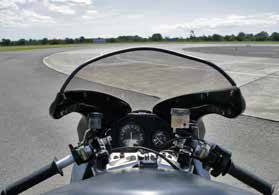
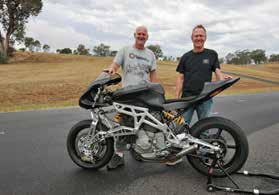
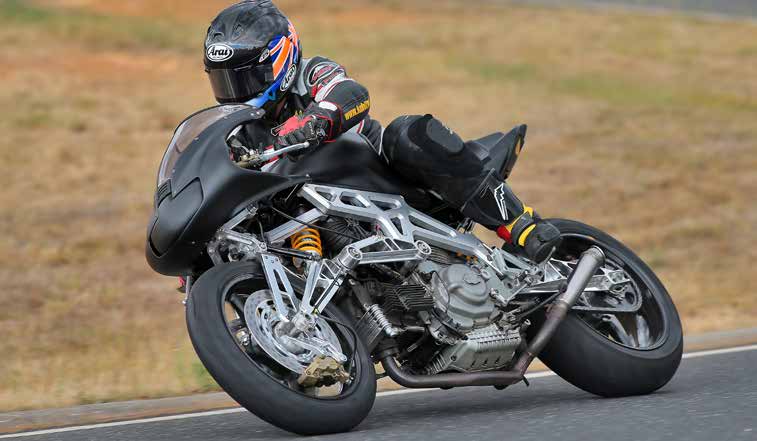


Specs
ENGINE
Configuration 90° V-twin
Cylinder head SOHC, desmodromic
two valves per cylinder
Capacity 904cc
Bore/stroke 92 x 68mm
Compression ratio 9.2:1
Cooling Air
Fuelling EFI, 2 x 45mm
throttle bodies
Power 58.3kW @ 7500rpm (claimed)
Torque 79Nm @ 6500rpm (claimed)
TRANSMISSION
Type Six-speed
Clutch Multiplate dry
Final drive Chain
CHASSIS
Frame material Machined billet
aluminium
Frame layout Twin spar
Rake 19º (variable 15-24º)
Trail 98mm (adjustable)
SUSPENSION
AFCO T2
Front: Fuly adjustable machined
billet-aluminium swingarm pivoting
in chassis spars
Rear: Fully adjustable machined billetaluminium
swingarm
WHEELS/TYRES
Wheels BST carbon fibre
Front: 17 x 3.5 Rear: 17 x 6.0
Tyres Pirelli Diablo Rosso
Front: 120/70 ZR17
Rear: 170/60 ZR17
BRAKES
Brembo
Front: Twin 320mm discs,
four-piston calipers
Rear: Single 220mm disc,
two-piston caliper
DIMENSIONS
Weight 161kg (dry, claimed)
Seat height Not given
Max width Not given
Max height Not given
Wheelbase 1394mm
Fuel capacity Not given
PERFORMANCE
Fuel consumption Not given
Top speed Not given
CONTACT & SALE INFO
Testbike Motorcycle Innovation Pty Ltd,
Brisbane, Queensland, Australia
Price N/A
Aus availability One day, we hope!
